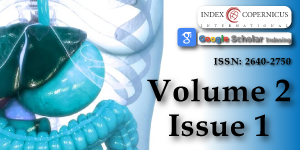Analysis of Pyogenic Liver Abscesses
Main Article Content
Abstract
Background: Pyogenic liver abscesses (PLA) are frequent in immunosuppressed patients. We review the characteristics of patients with PLA at a tertiary academic Spanish hospital in Asturias.
Methods: A retrospective observational study for 10 years, between 2006-2015. Epidemiological, clinical, analytical characteristics, treatment and hospital stay of the patients with PLA were analyzed.
Results: 99 patients, 62 (62.6%) men, with age ≥65 years (72.7%). The most frequent etiology was: Biliary (40%), postsurgical (15%) and intestinal origin (11%). The most frequent clinical signs were fever, showing significant differences, abdominal pain (p=0.001) and nausea (p=0.02) between biliary PLA and the rest of the PLA. Microbiological results were confirmed in 63% (62 cases). All were treated with antibiotic therapy, along with percutaneous drainage (44.4% (44 cases)); and surgical drainage (12.1% (12 cases)). The overall mean stay was 23.1 days without significant differences between those treated with percutaneous drainage or surgical drainage.
Conclusion: PLA predominate in patients ≥65 years. Biliary PLA are the most frequent, diagnosed at an older age than the intestinal PLA (p=0.005).
- The treatment is based on systemic antibiotherapy and percutaneous drainage, especially in PLA only >5cm (p=0.019).
- There are no significant differences in average stay of patients treated with percutaneous drainage or surgical drainage.
Article Details
Copyright (c) 2018 Barreiro Alonso E.

This work is licensed under a Creative Commons Attribution 4.0 International License.
Ruiz-Hernández JJ, León-Mazorra M, Conde-Martel A, Marchena-Gómez J, Hemmersbach-Miller M, et al. Pyogenic liver abscesses: Mortality-related factors. Eur J Gastroenterol Hepatol. 2007; 19: 853-858. Ref.: https://goo.gl/aQ8gse
Peris J, Bellot P, Roig P, Reus S, Carrascosa S, et al. Clinical and epidemiological characteristics of pyogenic liver abscess in people 65 years or older versus people under 65: A retrospective study. BMC Geriatr. 2017; 17: 161. Ref.: https://goo.gl/nhVXC3
Cosme A, Ojeda E, Zamarreño I, Bujanda L, Garmendia G, et al. Pyogenic versus amoebic liver abscesses. A comparative clinical study in a series of 58 patients. Rev Esp Enferm Dig. 2010; 102: 90-99. Ref.: https://goo.gl/4Z7sXX
Târcoveanu E, Vlad N, Moldovanu R, Georgescu S, Bradea C, Lupaşu C, et al. Pyogenic liver abscesses. Chirurgia (Bucur). 2008; 103: 417-427. Ref.: https://goo.gl/sqEuMX
Luo M, Yang X-, Tan B, Zhou X-, Xia H-, et al. Distribution of common pathogens in patients with pyogenic liver abscess in China: a meta-analysis. Eur J Clin Microbiol Infect Dis 2016; 35: 1557-1565. Ref.: https://goo.gl/uf1xKH
Haider SJ, Tarulli M, McNulty NJ, Hoffer EK. Liver abscesses: Factors that influence outcome of percutaneous drainage. Am J Roentgenol. 2017; 209: 205-213. Ref.: https://goo.gl/DBec4X
Chen SC, Tsai SJ, Lee YT, Yen CH, Huang CC, et al. Predictors of mortality in patients with pyogenic liver abscess. Neth J Med 2008; 66:196-203. Ref.: https://goo.gl/Gf88vi

